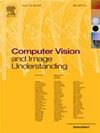语义保留的基于点的人类化身
IF 4.3
3区 计算机科学
Q2 COMPUTER SCIENCE, ARTIFICIAL INTELLIGENCE
引用次数: 0
摘要
为了实现AR/VR和数字娱乐的真实体验,我们提出了第一个基于点的人类化身模型,该模型体现了数字人类的全部表达范围。具体来说,我们使用两个mlp来建模与姿态相关的变形和线性蒙皮(LBS)权重。外观的表示依赖于解码器和附加到每个点的特征。与其他隐式方法相比,定向点表示不仅提供了一种更直观的方法来建模人类化身动画,而且显著减少了训练和推理的计算时间。此外,我们提出了一种新的方法将语义信息从SMPL-X模型转移到点,从而更好地理解人体运动。利用点的语义信息,通过在不同主题间交换相同类别的点,可以方便虚拟试穿和人的化身合成。实验结果证明了该方法的有效性。我们的实现可以在https://github.com/l1346792580123/spa上公开获得。本文章由计算机程序翻译,如有差异,请以英文原文为准。
Semantic-preserved point-based human avatar
To enable realistic experience in AR/VR and digital entertainment, we present the first point-based human avatar model that embodies the entirety expressive range of digital humans. Specifically, we employ two MLPs to model pose-dependent deformation and linear skinning (LBS) weights. The representation of appearance relies on a decoder and the features attached to each point. In contrast to alternative implicit approaches, the oriented points representation not only provides a more intuitive way to model human avatar animation but also significantly reduces the computational time on both training and inference. Moreover, we propose a novel method to transfer semantic information from the SMPL-X model to the points, which enables to better understand human body movements. By leveraging the semantic information of points, we can facilitate virtual try-on and human avatar composition through exchanging the points of same category across different subjects. Experimental results demonstrate the efficacy of our presented method. Our implementation is publicly available at https://github.com/l1346792580123/spa.
求助全文
通过发布文献求助,成功后即可免费获取论文全文。
去求助
来源期刊

Computer Vision and Image Understanding
工程技术-工程:电子与电气
CiteScore
7.80
自引率
4.40%
发文量
112
审稿时长
79 days
期刊介绍:
The central focus of this journal is the computer analysis of pictorial information. Computer Vision and Image Understanding publishes papers covering all aspects of image analysis from the low-level, iconic processes of early vision to the high-level, symbolic processes of recognition and interpretation. A wide range of topics in the image understanding area is covered, including papers offering insights that differ from predominant views.
Research Areas Include:
• Theory
• Early vision
• Data structures and representations
• Shape
• Range
• Motion
• Matching and recognition
• Architecture and languages
• Vision systems
 求助内容:
求助内容: 应助结果提醒方式:
应助结果提醒方式:


